Home Maintenance

Properly maintaining your home is an important part of making sure your fixtures and systems perform well, save water, and keep your utility costs down.
WaterSense recommends you follow some simple maintenance tips for your water-using fixtures, features, and systems. Check out daily, monthly, and annual maintenance tips in WaterSense’s Maintenance Checklist for a Water-Efficient Home and review more detailed information about maintaining a water-efficient home below.
On this Page:
- Whole-Home Considerations
- Maintenance Tips for Your Indoor Products and Appliance
- Operations and Maintenance for your outdoor features
Leaks
Leaks can spring up over time and, in addition to wasting water, can cause serious damage in your home! Regularly check your home for leaks and
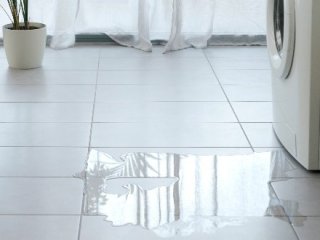
address any that you identify as soon as possible. WaterSense’s Fix a Leak Week web page includes tips, step-by-step instructions, and “bath hack” videos to identify and fix leaks the third week of March or any time of the year. Here are a few things you can do to stay on top of leaks:
- Contact your water utility to sign up for leak alerts if they are offered.
- Compare your monthly water bill to the same month of the previous year. If your water bill is significantly higher than the previous year, it may indicate an unidentified leak in your home. For homes with no outdoor water use in the winter, it’s likely that a family of four has a serious leak if its water use exceeds 12,000 gallons (or 16 hundred cubic feet [CCF]) per month during the winter.
- Find your water meter, which is usually located underground near the curb in front of your home. It could be inside (e.g., in the basement). Remove the lid and read your water meter during a period when no water is being used. Read it again two hours later. If the reading has changed, you probably have a leak in your home.
- Consider installing a leak detection or flow monitoring system, which can alert you of irregular water use patterns, detect unintended moisture, or even activate a shut-off valve to prevent further water loss.
- Once a year, check any leak detection or flow monitoring systems installed in your home to make sure they are operating correctly.
Service Pressure
Your water-using fixtures will operate best if your home’s incoming water pressure is between 45 and 60 pounds per square inch (psi). Your home may have a pressure-regulating valve (PRV) installed to maintain service water pressure in that range. You can check your service water pressure by using a water pressure test gauge (which you can find at the hardware store) on your hose bibb. To test the pressure, turn off all water-using fixtures and systems at your home, affix the gauge to the hose bibb, and turn the water on to the fully open position. If your service water pressure is much lower than 45 psi, you may need to find and fix a leak in your home. If it is much higher, you may want to have a professional adjust or install a PRV to help maintain water pressure at 60 psi.
Hot Water Systems
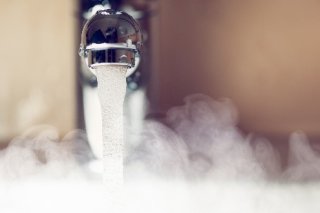
Performing regular maintenance on your water heating system will allow it to operate most efficiently. To ensure all aspects of your water heater are checked, it may be best to hire a professional to service your home’s water heater at least once a year. If you prefer to perform regular maintenance yourself, consult your water heater manual for instructions, review the U.S. Department of Energy’s Water Heating web page for more information, and consider these tips:
- On a regular basis, visually inspect your water heater for leaks, aged gaskets or loose connections/screws, and corrosion and repair identified issues as necessary.
- Once a year, flush your water heater to reduce sediment buildup which can decrease efficiency. After turning off power supply to your water heater, use a garden hose to empty the water heater into a space that can handle water at a high temperature.
- At least once a year, check the temperature and pressure valve to make sure it functions correctly.
- Consider insulating your tank and connecting pipes to reduce heat loss through the system.
- Consider installing a demand recirculating system, which recirculates water that has cooled back to the water heater until the desired temperature is reached.
Toilets
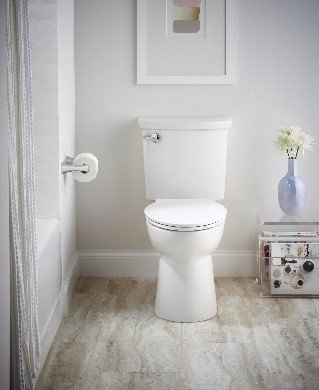
WaterSense labeled toilets are certified to meet EPA’s criteria for water efficiency and performance. However, all toilets require periodic maintenance:
- Check for silent leaks at least once a year by putting a couple drops of food coloring or a dye tablet into the tank at the back of the toilet and waiting 10 minutes. If the color shows up in the bowl, you have a leak that can probably be fixed by replacing the rubber flapper in the tank, which may be worn out. Don’t forget to flush afterwards to avoid staining the inside of the tank. Watch this video from Concord General Services to learn how to do the simple dye test.
- Since toilet flappers wear out, replace them at least once every five years to ensure a good seal and avoid leaks.
- Other parts of your toilet can malfunction, too. If your toilet is constantly running, if it won’t flush, if you lift the tank lid and see water continuously flowing into the overflow tube within it, or if you detect any other toilet problem, investigate further with help from videos and other resources on WaterSense’s Fix a Leak Week web page or contact your local plumber to help.
- If your home has a dual-flush toilet, make sure everyone knows how and when to operate the full-flush mode versus the reduced-flush mode.
- If you need to purchase a new toilet for your home, choose a WaterSense labeled model. Use the WaterSense Product Search Tool to find a list!
Showerheads

WaterSense labeled showerheads are certified to save water and provide a satisfying spray. No matter what showerhead you use, here are a few things you can do to keep your showerhead performing well:
- If you notice any drips or stray sprays from your showerhead, ensure there is a tight connection between the showerhead and the pipe using a wrench and pipe tape to secure it if necessary.
- Periodically inspect your showerheads for scale buildup and use a cleaning product or white vinegar to remove it.
- If your showerhead needs to be replaced, be sure to choose a WaterSense labeled model by visiting the WaterSense Product Search Tool. To learn how to replace the showerhead yourself, check out the WaterSense “bath hack” video on showerhead replacement.
Faucets
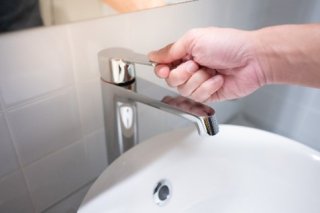
WaterSense labeled faucets are certified to use less water and perform well. Below are some tips to ensure the faucets in your home are operating efficiently:
- Monitor the faucets in your home for leaks by listening for drips and looking under sinks for leaks at pipe connections, puddling, or other water spots. WaterSense has videos to help you fix a leaky faucet or replace an aerator on WaterSense’s Fix a Leak Week web page.
- Periodically inspect your faucets for scaling or calcium buildup and use white vinegar or another cleaning product to remove any buildup that may be restricting flow.
- If a faucet or faucet aerator needs to be replaced, fine new lavatory faucets and aerators with WaterSense labeled models by visiting the WaterSense Product Search Tool, and replace kitchen faucets with models that have a flow rate between 1.5 and 1.8 gallons per minute (5.7 to 6.8 liters per minute).
Clothes Washers
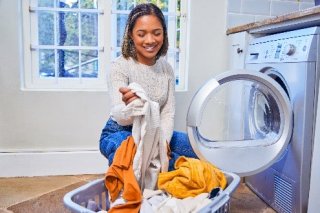
If your clothes washer is ENERGY STAR® certified, it uses less energy and water compared to standard models. To save even more water and energy, consider these additional tips:
- Run full loads whenever you can and skip pre-wash or extra rinse cycles unless you have heavily soiled clothes.
- Use an appropriate amount of detergent to avoid the need for extra rinsing.
- Set your washer to use cold water as much as possible and avoid the extra-hot sanitary rinse to save more water and energy.
- Leave the door open on your clothes washer after use to allow moisture to evaporate to prevent mold and follow other manufacturer maintenance recommendations, especially for front-load clothes washers.
- If your clothes washer needs to be replaced, look for ENERGY STAR certified models using the ENERGY STAR Product Finder and consider the washer’s Integrated Water Factor (IWF) value when making your purchase. A lower IWF indicates a machine with lower water use.
Dishwashers

Dishwashers can save you time in your kitchen, but did you know that they also save water and disinfect your dishes more effectively than hand washing? If your home has an ENERGY STAR certified dishwasher, it reduces your water and energy footprint even further. To continue to save water and energy in your kitchen, consider the following:
- Scrape food waste into a compost bin or trash can before loading into the dishwasher instead of rinsing.
- Only run full loads.
- If your dishwasher allows you to choose how your load is run, consider skipping extra rinse cycles.
-
If your dishwasher needs to be replaced, choose an ENERGY STAR certified model using the ENERGY STAR Product Finder and consider the dishwasher’s water use value (in gallons per cycle) when making your purchase. A lower gallons per cycle number indicates a machine with lower water use.
Water Softeners
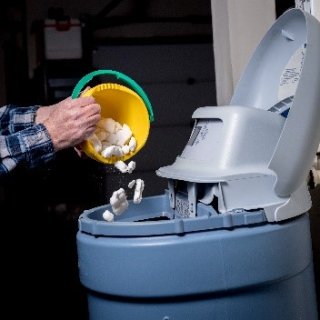
Water softeners are common in areas with hard water. They can be water-intensive, so only install one if your area’s water quality makes it necessary. Your water softener is filled with resin that has to be rinsed with salt water or brine periodically (a process referred to as regeneration) to allow for continued softening of water. To ensure your water softener performs well and uses water efficiently, hire a professional to service your system once a year. In addition, consider these tips:
- Periodically check the salt level of your water softener and add salt as necessary. Keep an eye out for salt bridges and break them up with a broom handle or similar rigid tool.
- Clean your water softener’s brine tank once per year.
- Work with a professional or the product manufacturer to program regeneration based on the incoming water hardness and/or flow through the system instead of regenerating on a set schedule.
- Whenever possible, temporarily put your water softener on bypass for water-intensive activities that don’t require softened water (e.g., watering the lawn, filling a wading pool).
- If you need to replace your water softener, select demand-initiated systems instead of systems with manual or auto-initiated regeneration. Look for systems that use four gallons (15 liters) of water or less per 1,000 grains of hardness removed. For salt efficiency, look for systems that can achieve at least 3,500 grains of hardness per pound of salt.
Soil Management and Mulching

Healthy soils and properly graded sites can help support plant growth and efficient water infiltration, reducing the need for irrigation. Below are some tips for reducing your outdoor water use:
- When landscaping, ensure that the topsoil is four to six inches deep so that it retains water from precipitation and releases it slowly back to plants.
- Add mulch to landscaped areas annually and weed the landscape regularly so that more water is available to your landscape plantings.
- Allow your grass to grow two to three inches tall before mowing to promote deeper root growth and more drought-resistant lawns.
- Consider aerating the soil (i.e., by making small holes) to loosen the soil in high-traffic areas of your landscape periodically to alleviate compaction and improve water infiltration.
- Additional landscaping tips.
Irrigation
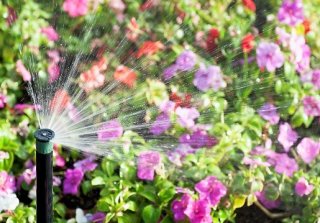
If you have an irrigation system, prioritize maintenance so you aren’t wasting water:
- Celebrate “Sprinkler Spruce-Up” with WaterSense every spring by inspecting your system to make sure winter weather didn’t damage irrigation equipment and lines. Check to make sure sprinklers aren’t spraying on pavement or hardscape and the drip lines are working properly without clogs or leaks.
- Monitor your landscape for signs of overwatering (e.g., pooling water or excessive growth) or underwatering (e.g., brown spots) and look for ways to optimize your system or change your schedule to ensure your system is operating efficiently.
- Use a WaterSense labeled irrigation controller, which waters only when and how much is needed, or adjust your clock-based timer regularly to account for seasonal weather conditions. Adhere to any water use restrictions in effect in your region.
- Since different soil types hold and distribute water in contrasting ways and may benefit from different methods of irrigation, you should evaluate your soil to figure out if it’s predominantly clay, silt, or sand. Unless your soil is predominantly clay, it may be beneficial to apply water in larger amounts less frequently to promote deep root growth and plant health. If your landscape is made up of clay soils or steep slopes, divide irrigation runtimes into smaller intervals with short breaks in between to allow water more time to soak into the soil (also called “cycle-and-soak”).
- Winterize your irrigation system by shutting off the water supply and draining the lines before freezing weather arrives.
- Use WaterSense’s Find a Pro tool to hire a certified irrigation auditor who has demonstrated knowledge of water-efficient techniques. EPA recommends an audit be conducted approximately every three years.
- Consider transforming parts of your landscape to reduce turfgrass and plant native or drought-tolerant species.
- If you plan to replace your irrigation controller or sprinklers, choose WaterSense labeled models by visiting the WaterSense Product Search Tool.
- Additional watering tips.
Pools
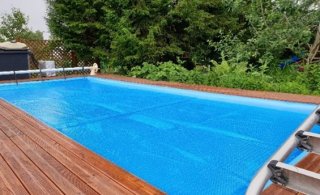
If your home has a pool, proper maintenance is critical for water-efficient operation. Visit the WaterSense Pool Water Efficiency web page for guidance on pool maintenance, and consider the tips below:
- Use a pool cover whenever the pool is not in use to avoid evaporation and consider setting a heated pool at a lower temperature.
- To minimize losses from splashing, set the pool water level to at least four inches below the edge of the pool and overflow drain.
- Vacuum your pool and skim the surface regularly to reduce the load on the filtration system and clean the filter only when necessary, rather than on a set schedule.
- Use a pressure gauge or sight glass to help you determine when filter cleaning is needed.
- If you need to replace your pool filter, consider the water efficiency of the various filter types by referring to WaterSense’s Jump Into Pool Water Efficiency guide.
- Instead of draining your pool and refilling it, consider mobile reserve osmosis treatment to prolong the pool water’s useful life.
- Be sure to test your pool’s automatic refill system and fill valve and otherwise monitor your pool for leaks using tips from WaterSense’s Jump Into Pool Water Efficiency guide.
- Winterize your pool by cleaning the pool water, balancing the pool chemicals, and adding winterization chemicals if needed. Before freezing temperatures arrive, drain water from filters, pumps, heaters, and piping.
